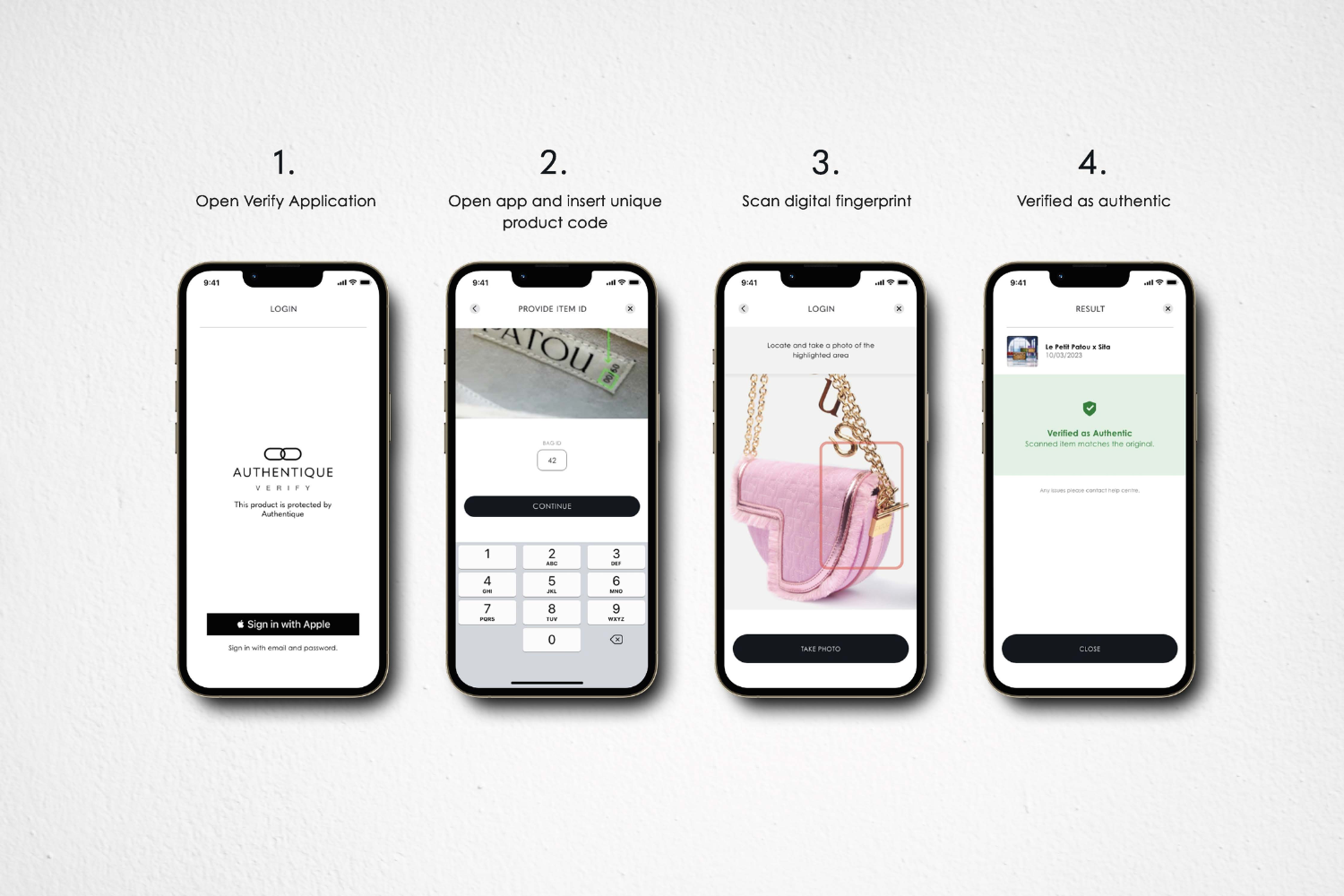Patou Launches AI-Powered Authentication System to Fight Fashion Counterfeits

Fashion brand Patou, which is owned by LVMH, has developed a new AI-powered authentication system called Authentique in partnership with tech firm Ordre.
The technology creates a digital fingerprint of designated areas of a bag during production, and a customer can later verify its authenticity using the app by taking a picture of the same area.
“Authentique’s algorithm analyzes the picture on a microscopic level, translating the data into a numeric code and creating a digital ID for the product it stores as an NFT so it can’t be altered,” according to Lock, the co-founder of Authentique. “Later, in the app, a user will see a faint overlay directing them to align the camera with the same location on the product. Once they snap a picture, the app compares the code generated from the image with the one on file. Because it’s just comparing numerals rather than matching images pixel by pixel, it requires minimal computing power.”
Lock also stated that the technology can currently authenticate clothing, shoes, and small leather goods. He predicts that within a year, Authentique will be able to add watches and jewellery to the list. Its accuracy rate for separating real from fake products is greater than 99% and is expected to improve.
The system could be scaled up to other widely-released products, but only if it has a large enough dataset to train the algorithm, according to Lock.
Counterfeiting is a significant problem for the fashion industry, and it is getting worse as the online marketplace makes it easier for counterfeiters to sell their products. In 2019, the global trade in fake and pirated goods reached $464bn, with fashion products being the most frequently seized by global customs.
The problem has persisted for centuries, and luxury brands have typically relied on trained authenticators to spot fakes. However, more are turning to AI in the hope that it can recognise patterns indiscernible to humans, separating even the best reproductions from the genuine article. The hope is that AI can provide a new weapon in the arms race against counterfeiters, whose methods are constantly improving.
The fast-growing secondhand market is where AI could have the greatest impact, as resale players such as The RealReal and StockX contend with allegations of fakes slipping through their defences.
The trend towards the use of AI for authentication and verification is backed by evidence that suggests AI could be helpful. Researchers at Case Western Reserve University were able to attribute similar paintings to the correct artists with high accuracy just by analysing a small patch of each one’s surface topography. “The AI methods are applicable across the board,” said Andrew Van Horn, a Case Western Reserve post-doctoral fellow in data science in art. But he cautioned the best results will come from a mix of technology and trained humans who know what to look for.
While Authentique’s development is aimed at catching counterfeit items before they enter the marketplace, established player Entrupy has been catching fakes amid the vast ocean of products already in circulation since 2012. The company has trained its AI on a massive dataset collected from both authentic and counterfeit items reaching back decades.
“We get a lot of that information from customers around the world,” said Vidyuth Srinivasan, co-founder and CEO, noting Entrupy works with brands, retailers, and even governments.

Clients use special hardware, like an optical device the company provides that can attach to an iPhone and works like a microscope, or a lighted box that can photograph products from different angles. Comparing the data from those images with the information it has collected lets it identify fakes with greater than 99 per cent accuracy, according to Srinivasan.
“While a shopper who purchases a new bag directly from Patou may be reassured they can verify its authenticity, it’s the secondhand buyer most in need of the technology,” said a recent Business of Fashion (BoF) report. The report cited OECD data, which showed that footwear is most often faked, and that Nike is the most counterfeited brand in the world, according to the World Customs Organization.
In light of this, resellers such as StockX are having to be vigilant. While StockX has been using Entrupy’s tech to authenticate items, the company has been developing its own system that uses AI and machine vision to catch fakes when they go through its authentication centres.
Similarly, The RealReal has introduced its own visual AI system called Vision to spot fakes and complement its Shield programme, which uses AI for spotting high-risk products and sellers.
However, both companies stressed that their systems are not meant to replace human authenticators who have extensive product knowledge.
Overall, the use of AI in the fight against counterfeit goods in the fashion industry is a promising development. While it is unlikely that AI will completely eradicate the problem, it has the potential to significantly reduce the prevalence of fake products and protect both brands and consumers.
As the technology continues to evolve, it will be interesting to see how it is integrated into the broader landscape of fashion authentication and what impact it has on the industry as a whole.

